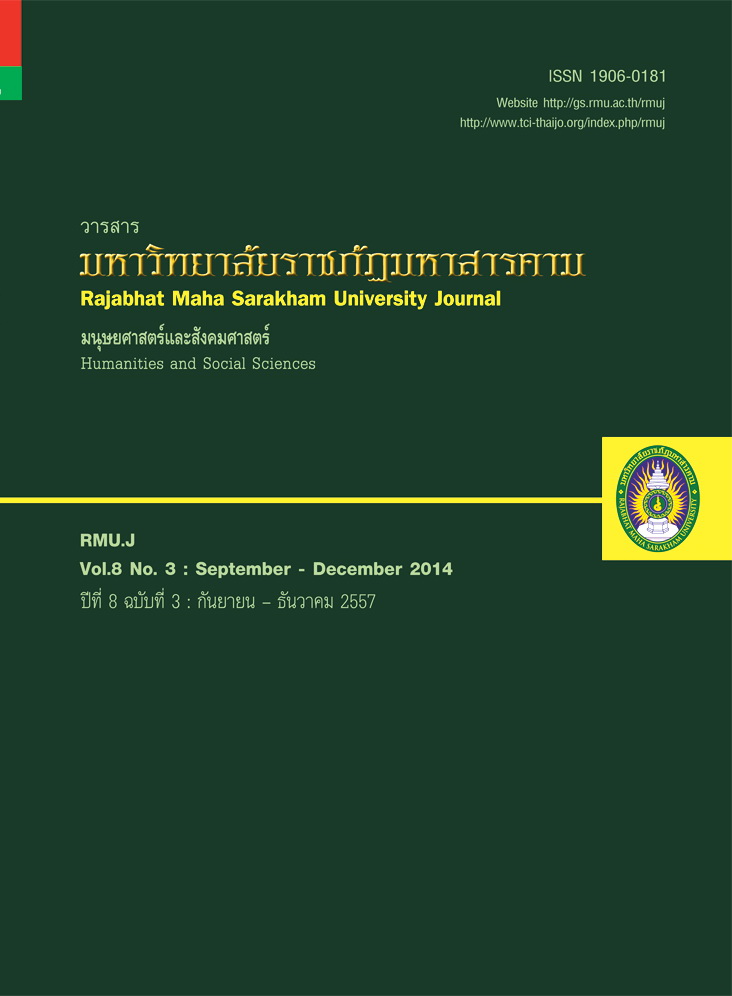การพยากรณ์ความผันผวนของราคายางแท่ง เอส ที อาร์ 20 ในตลาดสินค้าเกษตรล่วงหน้า แห่งประเทศไทย Forecasting the Price Volatility of Block Rubber STR 20 in the Agricultural Futures Exchange of Thailand
Main Article Content
บทคัดย่อ
การศึกษาครั้งนี้มีวัตถุประสงค์เพื่อให้ได้แบบจำลองที่สามารถพยากรณ์ความผันผวนของราคายางแท่งเอส ที อาร์ 20 ในตลาด
สินค้าเกษตรล่วงหน้าแห่งประเทศไทย ที่มีความถูกต้อง แม่นยำ สามารถนำไปประกอบการตัดสินใจในการซื้อหรือขายในช่วงเวลาที่มี
ความเหมาะสม เพื่อเป็นการลดความเสี่ยงจากการดำเนินธุรกิจ ซึ่งเป็นการเปรียบเทียบระหว่างแบบจำลองการ์ชและเทคนิคการทำให้
เรียบแบบเอกซ์โปเนนเชียลชั้นเดียว โดยใช้กลุ่มตัวอย่างเป็นข้อมูลราคาสัญญาซื้อขายเดือนส่งมอบ กันยายน 2555 ตั้งแต่ 30 มกราคม
2555 ถึง 29 สิงหาคม 2555 รวมทั้งสิ้น 153 ข้อมูล นำมาวิเคราะห์หลักทางอนุกรมเวลา โดยตรวจสอบข้อมูลให้มีลักษณะนิ่งก่อนนำ
ไปใช้งาน สำหรับการทดสอบในครั้งนี้จะใช้ Augmented Dickey-Fuller Test ในการตรวจสอบความนิ่งและใช้ Kwiatkowski
Phillips Schmidt Shin Test อีกครั้งเพื่อเป็นการยืนยันผลการทดสอบ หากข้อมูลมีลักษณะไม่นิ่งจะทำการหาผลต่างจนกว่าข้อมูล
จะมีลักษณะนิ่ง แล้วจึงทำการสร้างแบบจำลองที่ดีที่สุดของแต่ละตัวแบบเพื่อเปรียบเทียบประสิทธิภาพในการพยากรณ์ ซึ่งเทคนิคการ
ทำให้เรียบแบบเอกซ์โปเนนเชียลชั้นเดียว จะเลือกค่า Alpla โดยพิจารณาจากค่าความคลาดเคลื่อนที่น้อยที่สุด ส่วนตัวแบบการ์ช
จะเลือกแบบจำลองจากการพิจารณาค่า AIC ที่ตํ่าที่สุด โดยกลุ่มตัวอย่างจะถูกแบ่งออกเป็นสองส่วนสำหรับการใช้สร้างแบบจำลอง
และสำหรับใช้เปรียบเทียบกับค่าพยากรณ์ของตัวแบบ ผลการวิจัยพบว่า
เทคนิคการทำใหเ้ รียบแบบเอกซโ์ ปเนนเชียลชั้นเดียว มีประสิทธิภาพในการพยากรณม์ ากกวา่ ตัวแบบการช์ ทั้ง 3 ชุดการทดลอง
ซึ่งเป็นการเปรียบเทียบด้วยการสร้างค่าพยากรณ์ล่วงหน้า 1 คาบเวลา สามารถนำเทคนิคการทำให้เรียบแบบเอกซ์โปเนนเชียลชั้นเดียว
ไปเป็นตัวช่วยในการตัดสินใจซื้อหรือขายในระยะสั้นๆได้
The objective of the study was to find the most suitable model which can forecast price volatility of
block rubber STR20 accurately and precisely in the agricultural futures exchange of Thailand and can also
be used to help with making decisions on trading block rubber STR20 at appropriate time and reducing
business risk. This study focused on comparing between GARCH model and single exponential smoothing
by using a sample of block rubber STR20 prices for the contract month of September 2012. The data were
collected from January 30th to August 29th, 2012, making a total of 153 ; and they were then examined to assure that they were stationary with 2 tools of time series analysis. Firstly, Augmented dickey-fuller test was
employed and followed by Kwiatkowski-Phillips-Schmidt-Shin test to confirm the data stability. Data differencing
had to be calculated until the data were stationary in order to make optimum models for each model type.
The efficiency of single exponential smoothing models were decided by comparing their smoothing constant
(Alpha). A model, the alpha of which had a minimum of the sum of squared error, was chosen. The best
GARCH model was the one with the lowest AIC. The samples were divided into 2 groups: one for making
models and the other for comparing the forecasting values of the 2 models. Findings showed that the single
exponential smoothing model outperformed GARCH model in all the 3 sets of the experiments compared by
making one-step-ahead forecasts. Thus, it can be concluded that GARCH model is not suitable for a short-run
forecast regarding this particular sample whereas the single exponential smoothing technique is less
complicated and performed more efficiently than GARCH.
Article Details
1. บทความที่ลงตีพิมพ์ทุกเรื่องได้รับการตรวจทางวิชาการโดยผู้ประเมินอิสระ ผู้ทรงคุณวุฒิ (Peer Review) สาขาที่เกี่ยวข้อง อย่างน้อย 3 ท่าน ในรูปแบบ Double blind review
2. ข้อคิดเห็นใด ๆ ของบทความที่ลงตีพิมพ์ในวารสารมหาวิทยาลัยราชภัฏมหาสารคาม นี้เป็นของผู้เขียน คณะผู้จัดทำวารสารไม่จำเป็นต้องเห็นด้วย
3. กองบรรณาธิการวารสารมหาวิทยาลัยราชภัฏมหาสารคาม ไม่สงวนสิทธิ์การคัดลอกแต่ให้อ้างอิงแสดงที่มา


